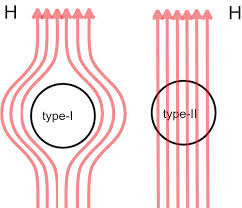According to Nicholas Gerbis
there are two main types of superconductors. They are
classified according to how they react in a magnetic
field. The two types are:
Type 1: These are usually made of pure metal. When it is cooled below its critical temperature it exhibits zero resistivity and displays perfect diamagnetism. This means that the magnetic fields cannot penetrate it while it is in the superconducting state.
Type 2: These superconductors are usually alloys and their diamagnetism is more complex.
All superconductors have a critical magnetic field. This is the field that either makes or breaks its superconducting state. Type 1 superconductors change states of matter once at one threshold. Type 2 superconductors can change states twice at two different magnetic field thresholds.
This is important because of what is known as the Meissner effect. This is the reason why superconductors can levatate permanent magnets as shown on the bottom left. The superconductor doesnt allow the magnetic field to penetrate it. It actually mirrors the field. This is what causes the levatation. Type 1 superconductors always have the Meissner effect. Type 2 superconductors can get caught between their magnetic field thresholds and partially allow magnetic fields to permeate them causing flux. This is shown in the diagram below.
Type 1: These are usually made of pure metal. When it is cooled below its critical temperature it exhibits zero resistivity and displays perfect diamagnetism. This means that the magnetic fields cannot penetrate it while it is in the superconducting state.
Type 2: These superconductors are usually alloys and their diamagnetism is more complex.
All superconductors have a critical magnetic field. This is the field that either makes or breaks its superconducting state. Type 1 superconductors change states of matter once at one threshold. Type 2 superconductors can change states twice at two different magnetic field thresholds.
This is important because of what is known as the Meissner effect. This is the reason why superconductors can levatate permanent magnets as shown on the bottom left. The superconductor doesnt allow the magnetic field to penetrate it. It actually mirrors the field. This is what causes the levatation. Type 1 superconductors always have the Meissner effect. Type 2 superconductors can get caught between their magnetic field thresholds and partially allow magnetic fields to permeate them causing flux. This is shown in the diagram below.
